~ continued from page 1 ~
Green acres: There are tree-covered hills and mountains as far as the eye can see in the Messenia region of the Peloponnese
Day 1: Mavromati and Ancient Messini
Immediately after arriving at Athens International Airport on an overnight flight from Toronto, we met up with friends and drove directly to the Messenia region of the Peloponnese where we stayed in Mavromati, a mountainside village overlooking the Ancient Messini archaeological site. We spent the night at Messana Hotel, which I have written about in my post Where to eat and sleep well in Mavromati.
Parts of the extensive archaeological site of Ancient Messini are shown in the two photos above. My posts Moments in Mavromati and Admiring the Arcadian Gate describe the attractions we saw during our short time in the area.
Day 2: Samarina, Androusa, Pylos, Methoni and Marathopoli
Our Day 2 drive commenced with a stop at the Samarina monastery, described in my post Samarina: The beautiful Byzantine church in Messenia.
.A short drive to the south of Samarina brought us to the quaint and quiet village of Androusa, where we parked the car and took a walk down the main road, admiring cute houses like this one.
We then walked a few hundred meters up a side road to wander around the remains of the Androusa Castle, a Frankish fortress built in the late 1200s. The ruins consist mainly of various wall sections, so there isn’t an intact castle to explore. But the hilltop site has beautiful panoramic views of the lush green landscape that extends to Kalamata and the Messenian Gulf coast.
Next up was a visit to Pylos, a pretty harbour town built on rolling hills that overlook the Gulf of Navarino. Though we had limited time to wander the streets and take a coffee break at a waterfront cafe, we liked the look and feel of the town a lot, and hope to return sometime for a few days.
Another view of part of the Pylos waterfront. Because of its proximity to beautiful beaches, castles, ruins and other historic sites, we think Pylos would be an ideal place for us to base ourselves for several days on a future trip to the Messenian coast.
After working up a sweat sightseeing in the heat and blazing sun, we cooled off with frappes on the shaded seaside patio at Poseidonia Restaurant, before strolling around the town for another hour.
Unfortunately, our travel schedule for the day didn’t allow us time to visit the 16th-Century Neokastro at Pylos, so we had to settle for seeing only some of the castle’s external fortification walls …
… which was a shame, since the Neokastro looks striking in videos and photos, including this aerial image from the Sites of Interest page of the Costa Navarino website. But we weren’t completely disappointed since we had already planned to visit another remarkable castle, and it was the next stop on our agenda.
The Venetian-era Methoni Castle was one of the must-see attractions on our itinerary, and we had fun exploring the extensive grounds and buildings for a couple of hours. Above is a view of the castle’s Bourtzi sea fortress …
… while this is a view of the castle from the walkway to the Bourtzi
Visitors can climb atop some of the castle walls to look across the vast historic site and gaze at the impressive coastal scenery. This is a view looking west from a vantage point atop one of the ramparts. The castle is enormous and we weren’t able to explore the entire site in the time available, though we did manage to cover a lot of ground before the sun, heat and hunger convinced us it was high time for a lunch break.
We had worked up a hearty appetite and thirst while walking around Methoni castle, so meandered to the nearby Akrogiali Taverna for lunch. The food was delicious and the pleasant views from our sea- and beach-side table made our meal at Akrogiali even more enjoyable.
We saw some of the town of Methoni while driving to and from the castle, and during walks before and after lunch. It was exceptionally quiet the afternoon we were there and we almost had the entire place to ourselves, with few other tourists or locals in sight. Like Pylos, it’s an attractive town we would like to revisit for a longer time. This is one of the streets close to the castle.
From Methoni we drove west to the small coastal town of Marathopoli, where we checked in to the lovely Artina Nuovo Hotel for a 2-night stay
Once we had settled into our spacious apartment, we set out for a walk around the town and then enjoyed a bottle of wine with this wonderful sunset view from our big private balcony
Later that evening, we had an excellent dinner of traditional Greek dishes at Panorama Fish Tavern – Restaurant on Marathopoli’s taverna-lined seafront
Day 3: Voidokilia beach, Navarino Castle, Romanos and Marathopoli
We spent most of our third day around and near the Gulf of Navarino, where we enjoyed beautiful beaches and wetlands, a hike to the ruins of the ancient Navarino castle, and fabulous views of the region
While driving along the western coast of the Gulf of Navarino we passed several appealing golden sand beaches before stopping at the least busy of the bunch, Ntivari, where we saw just three or four other people enjoying the sun, soft sand and shallow water. This part of the beach faces Sphacteria island (also spelled Sfaktiria) across the bay.
A view of Ntivari beach and the Gulf of Navarino from a footpath leading to the Castle of Navarino ruins. While one of our group chose to stay on the beach to sunbathe and swim, the rest of us hiked up the big hill to see what’s left of the castle, and to experience the stunning views from there of Voidokilia beach — another of the “must-see” attractions on our tour of Messenia.
The walk to the castle begins on a dirt road, then continues up a very long trail that steadily becomes more difficult to climb as you approach the ruins. Outside the castle walls, and inside what’s left of the crumbling fortress, walking becomes challenging and even treacherous at times, since the loose rocks and boulders covering the ground make it easy to slip and twist an ankle. Safety hazards like that are among the reasons the castle actually is closed to visitors — but we didn’t learn that it’s supposed to be off-limits until after our visit.
Navarino castle comes into view
Almost there: the trail is barely visible as it snakes through the tall grasses and shrubs below the castle wall
Tourists walk along a section of the castle’s fortification wall. In the background is part of Spacteria Island.
The views from the castle wall are fabulous, but I wouldn’t recommend that anyone with vertigo or a fear of heights attempt to walk atop the wall.
The narrow, uneven footpath atop the wall is about two to three meters above the ground, which is covered by overgrown prickly shrubs and bushes, as well as mounds of rocks and boulders. You wouldn’t want to trip and tumble onto any of that, of course, yet winds blowing in from the sea can easily make you lose your balance. Along sections where the outer walls have collapsed, there’s nothing to grab onto if you do stumble or get blasted by a sudden gust of wind. The views are a constant distraction, but you really must watch your step or you could easily fall and get hurt.
This opening in the castle wall offers a glimpse of the Gialova lagoons
At last, a direct view of the main reason we had undertaken our long trek to the castle: the incredible Voidokilia beach, which is shaped like the letter Ω (Omega) from the Greek alphabet
A lookout point in the castle ruins gave us this marvellous view of Voidokilia beach and bay in the foreground, the Gialova lagoons at upper right, the Costa Navarino seaside at upper left, and mountains to the north. Though there were many times we cursed ourselves for undertaking the perilous walk through the castle ruins just so we could enjoy this sight, I’m glad we did it — the view was unforgettable and well worth the effort.
Seeing Voidokilia from above wasn’t enough — we wanted to spend some time on it, too, and I was determined to walk the full length of the Omega-shaped arc of soft, light-brown sand. So we descended the castle hill, got back in the car and drove around the Gialova lagoons to reach the beach access road. I shot this photo from the west end of Voidokilia, looking directly toward the spot where the sand ends on the east side. Navarino Castle sits atop the big rocky hill that rises behind that part of the beach.
A panoramic view from the west end of of Voidokilia beach
Dunes dotted with shrubs and grass ring the sandy beach. Beyond the dunes is a protected environmental area of wetlands and lagoons
A panoramic view of the eastern end of Voidokilia beach. The cave of King Nestor is situated above this end of the beach, but we didn’t venture up to see it.
Feeling famished following our Navarino Castle trek and our beach time at Voidokilia, we searched out KateRina’s Restaurant in the nearby Romanos area of Costa Navarino. The taverna had been highly recommended to us, and it lived up to its reputation — the food was delicious, and Katerina was a delightful host.
During our drive out of Romanos, we detoured down a side road that wound past extensive groves of olive trees
Some of the trees had massive, wide trunks, like this one, which indicated they could be several hundred years old.
After returning to our hotel in Marathopoli in early evening, we took a long walk to get better acquainted with the town. This is a harbour near our hotel.
One of things we appreciated most about Marathopoli was its long pedestrian promenade on the seaside. Attractively paved with flagstones, the path leads past numerous cafes, bars and tavernas whose open-air terraces overlook the Ionian Sea and nearby Proti island (shown above), which locals told us is a must-see for its secluded beaches and scenic coves. Unfortunately, the excursion boats from Marathopoli to Proti weren’t yet operating for the summer, so we weren’t able to visit the island on this trip.
There wasn’t a soul in sight when we walked this restaurant-lined side street in Marathopoli, and there wasn’t much traffic on the town’s main street, either. But only a couple of hours later the commercial area was bustling with people once shops and restaurants had opened for the evening.
We watched another beautiful sunset during our second and final night at the Artina Nuovo hotel
Because we’d had a huge lunch at KateRina’s in Romanos, we didn’t feel peckish again until late in the evening. Excellent reviews drew us to Artoinos Μεζεδοπωλείο, where we enjoyed drinks and a selection of mezes (appetizer-style plates of vegetable and meat items that are ideal for sampling and sharing). The reviews were spot on — the mezes were delicious, and the portion sizes just right. We could not have asked for a better restaurant to conclude a wonderful day in the region.
Day 4: Kyparissia and Katakolo
After a good breakfast at our hotel in Marathopoli, we checked out, packed up the car, and hit the road. We planned to visit Kyparissia for a few hours before working our way farther north to Katakolo, where we would spend the night. But when we arrived at Kyparissia, stormclouds had filled the sky above the town, and it looked like rain showers or even a thunderstorm might be brewing. Fortunately the threatening clouds moved inland, where they lingered over the mountains. We heard some thunderclaps, and felt a few drops of rain, but it stayed mainly sunny otherwise and turned out to be a beautiful day.
We proceeded to Kyparissia’s hilltop Old Town district and found a parking spot on Eleni Chameri Street (above). It was a convenient spot to start our walkabout, since it was close to the Venetian-era Kyparissia Castle, as well as a selection of cafes, tavernas and shops.
Although there’s just stone fortification walls, some crumbling buildings and a small amphitheatre on the castle site, it was well worth visiting since it has superb vantage points for viewing the town
One of the castle views of the town of Kyparissia
Castle view of the lowlands and coast to the northwest of Kyparissia
A flower and plant lover’s house in Kyparissia
Kyparissia is chock full of colourful, rustic buildings, most of which are either occupied or undergoing extensive restoration and renovations. There are dozens of derelict and abandoned homes and commercial structures, too, which we thought had amazing potential as “fixer uppers.” If only we had the money to buy one of these buildings — and the skills to restore it!
A charming old kafenion on Eleni Chameri Street
This once-elegant building cries out for restoration — we thought it would be perfect for a boutique hotel or a bed and breakfast
A church in Kyparissia
Algorithmos Cafe Bar, where we took a coffee break
Once we had finished our Kyparissia sightseeing, we went to Palia Agora restaurant on Eleni Chameri Street for a late lunch. The superb food and service made this meal one of our most memorable dining experiences in 2017. Likewise, Kyparissia ranked as one of our favourite towns. We enjoyed every minute there, and wished we had been able to stay overnight or for a few days. I’m sure we’ll be back!
Our driving route from Kyparissia to Katakolo took us through the city of Pyrgos, which is the capital of the Elis region of Greece (Ileia in Greek) . The population of the city and wider municipal region is around 45,000, but Pyrgos looked and felt considerably larger — perhaps because we were passing through at the end of the business day just as the streets were teeming with “rush hour” traffic. It was a sharp contrast from the calm and quiet of Kyparissia.
Abouty 11 km north of Pyrgos we reached our final destination for the day, the port town of Katakolo. We checked into the aptly-named Orizontes View Hotel which has this sweeping panoramic view of the town and bay from its position atop Katakolo Hill.
Our balcony faced west toward the Ionian Sea, but if we peeked around the corner wall could see Katakolo, the beachfront and cruise ship port
After we had settled in our hotel room, we ventured out for a closer look at Katakolo. This stone-paved pathway was a quick shortcut to the commercial center — the walk down the hill took us only 10 minutes.
A colourful house beside the pathway on Katakolo Hill
When we arrived at Katakolo just past 5 p.m., we saw a large cruise liner heading out to sea. That wasn’t a surprise — because of its close proximity to the historic site of ancient Olympia, Katakolo is a popular port of call on the Mediterranean cruise ship circuit. What we didn’t know is that the town’s tourist infrastructure is almost totally geared to the cruise ship traffic. Although the commercial center looked lively when we drove through on the way to our hotel, we didn’t realize that businesses were about to close their doors for the day. When we walked into Katakolo less than two hours later, the place was practically deserted. Two or three waterfront tavernas were still open, but virtually every other shop, restaurant and cafe was shuttered, and the streets were empty. A local resident explained that all the businesses open while cruise ships are in port, but close soon after the last vessel leaves since there is little demand for their services at that point. We briefly considered driving to Pyrgos, where everything would still be open, but decided to stay put and have a quiet night at our hotel instead.
Since there wasn’t much to see in the town, we walked back up Katakolo Hill to watch the sunset. We figured that if we followed the road that led past our our hotel, we would find a good vantage point, but the route didn’t pass along the coast as we had anticipated. Then clouds quickly moved in to obscure the sun before it dipped below the horizon. Although the sunset wasn’t as brilliant and dramatic as the two we had seen in Marathopoli, we did enjoy our walk through the peaceful countryside.
Back at the Orizontes View, we relaxed with drinks and snacks on the hotel’s seaview patio while watching darkness descend over Katakolo. This was our final night in the Peloponnese for 2017, and it left us wishing we could spend more time in the area.
Day 5: Departing from the Peloponnese
A temple at Ancient Olympia, a UNESCO World Heritage Site, is shown in this photo by Francesco Bandarin. We had originally hoped to visit Ancient Olympia in the morning, then drive to the port at Kyllini to catch the afternoon ferry to Kefalonia. But when we reviewed our plans over breakfast, we realized we would wind up spending most of the day in the car if we did that. It would take about an hour to reach Olympia, but then we would have to retrace the same route before continuing onward to Kyllini. It didn’t seem worthwhile to spend more time driving than exploring the historic site, so we regrettably agreed to leave Olympia for another trip, and proceed to directly to Kyllini instead.
The scenery along the route to Kyllini was largely unremarkable, but the town of Kyllini looked quite pleasant as we drove through on the way to the ferry port. We saw several tavernas and cafes that would have been nice to visit if we had enough time. I had thought that Kyllini is just a place where you arrive on or depart on ferries, but the area as a whole has much more to offer than its ferry connections to some of the Ionian islands. As the local destination website Kastro Kyllini shows, the region boasts beautiful beaches, historic sites and natural attractions. It’s a place we would consider staying at for a few days should a future trip take us to the area.
The Kefalonian Lines ferry Nissos Kefalonia was loading vehicles and passengers when we arrived at the port, so we collected our tickets and boarded the ship. Above is a view from the ferry of the stunning turquoise sea at Kyllini port. Our visit to the western Peloponnese was ending, but new sights and scenery were awaiting us on Kefalonia.


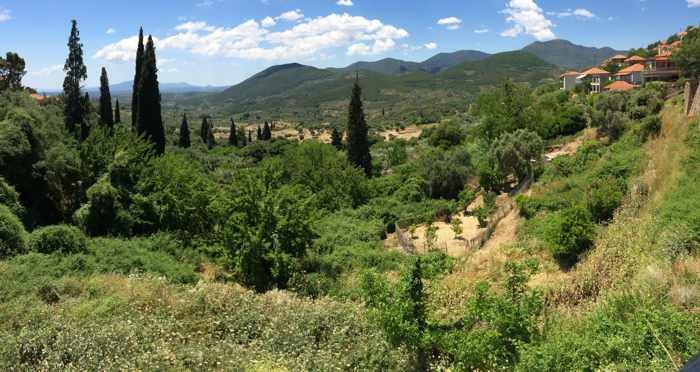
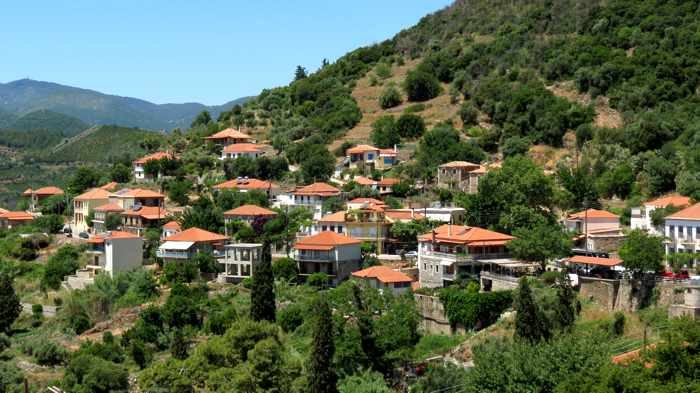
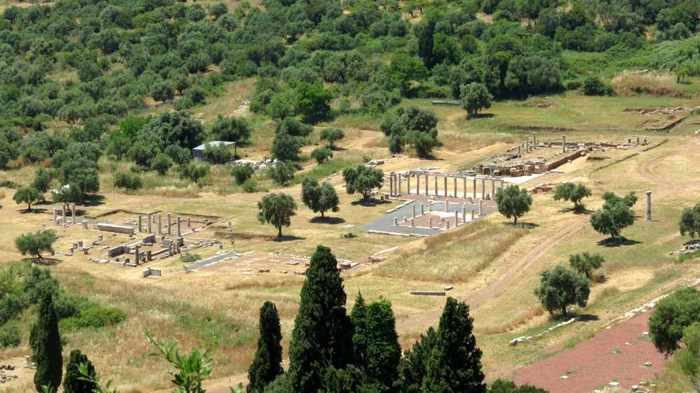
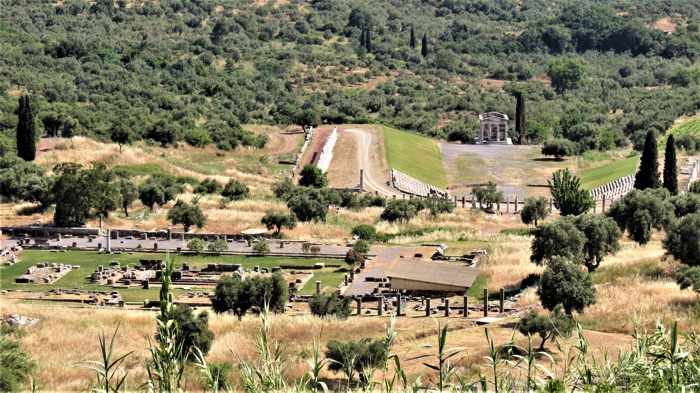
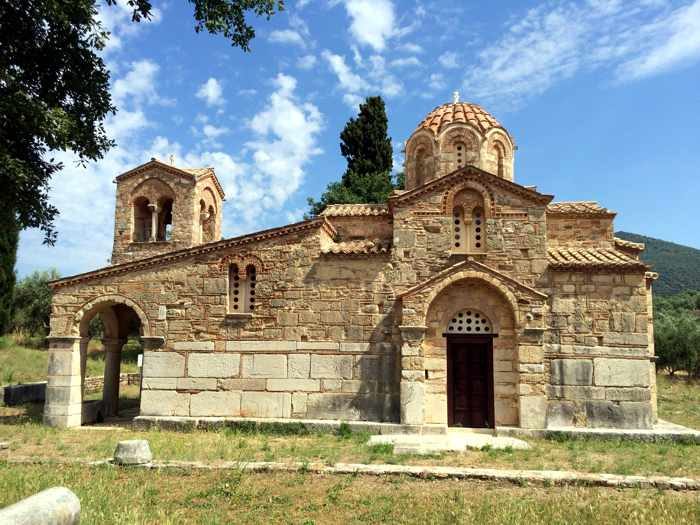
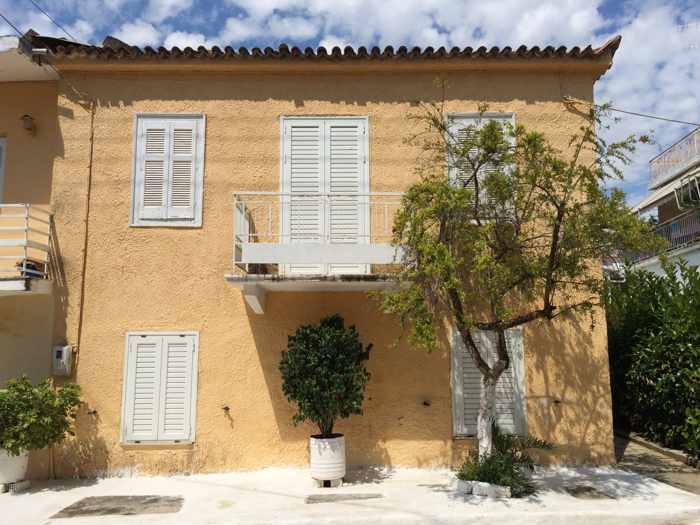
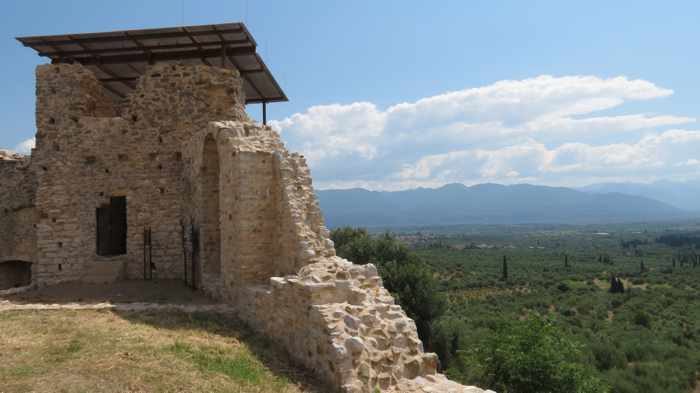
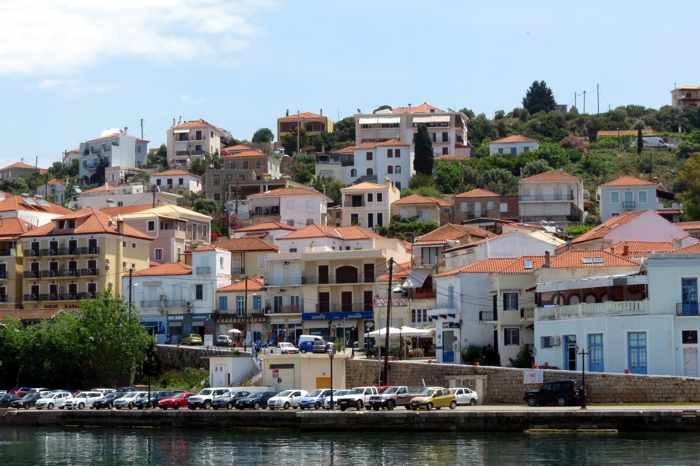
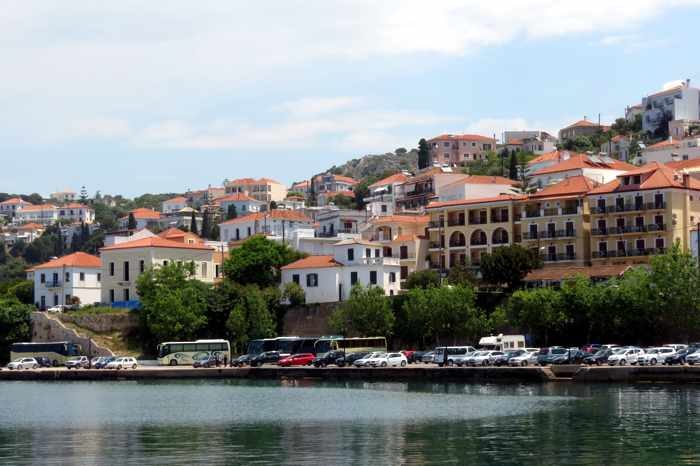
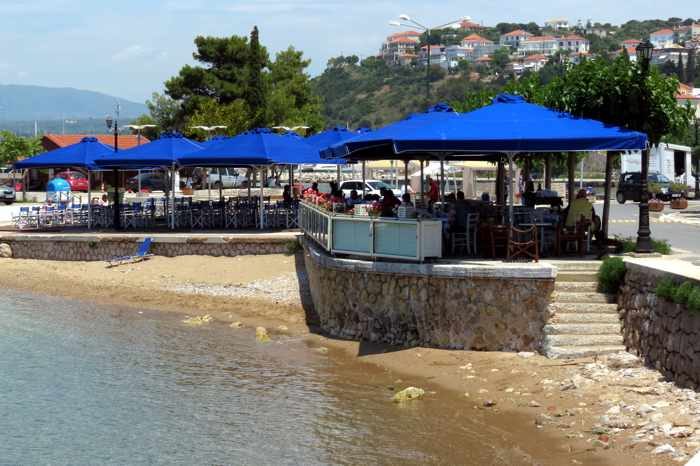
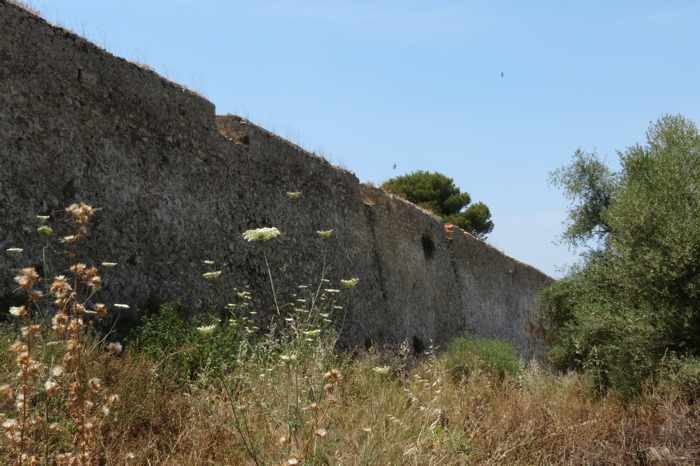
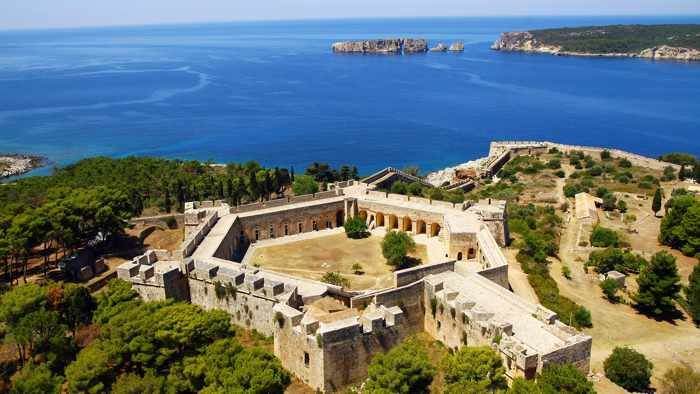
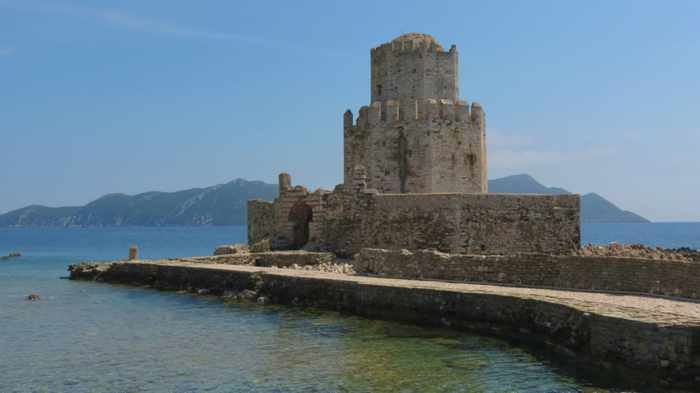
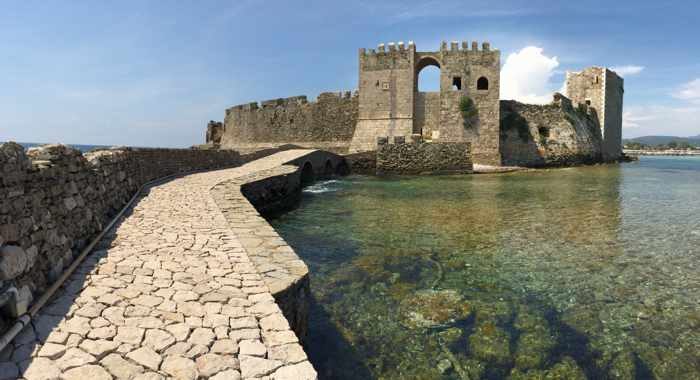
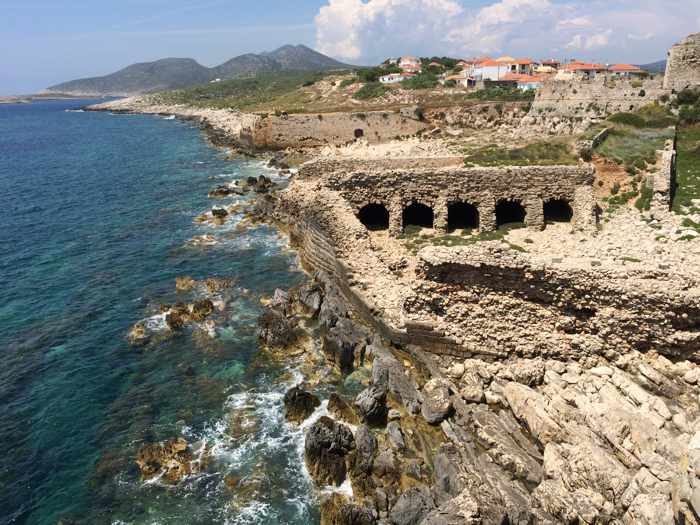
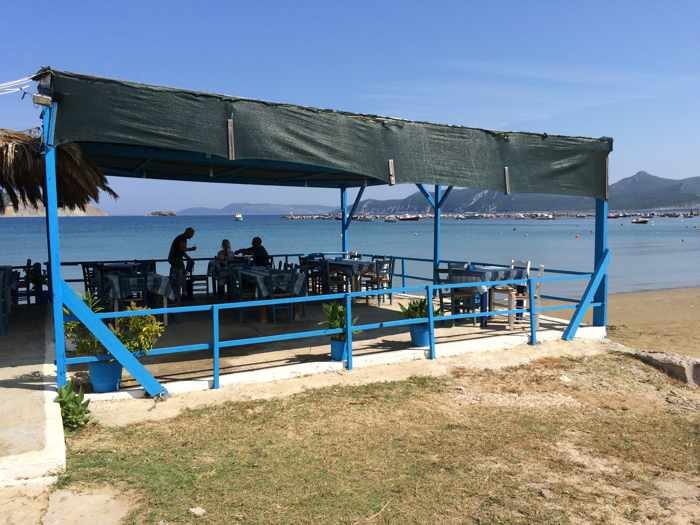
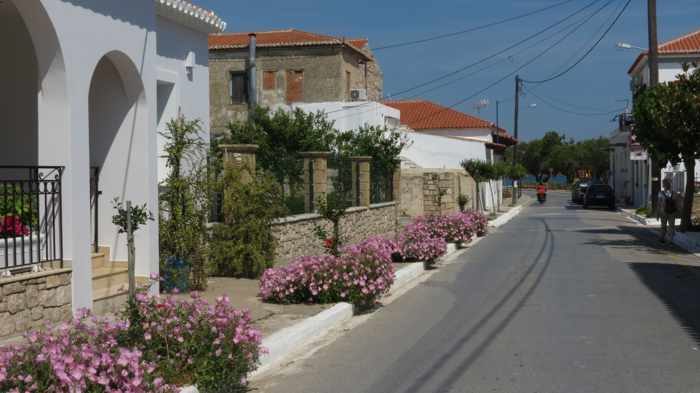
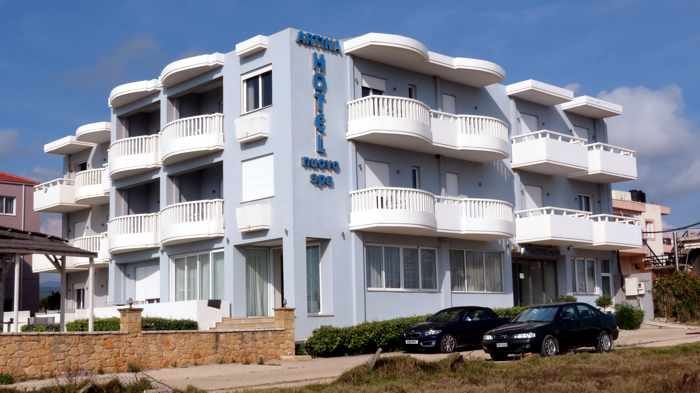
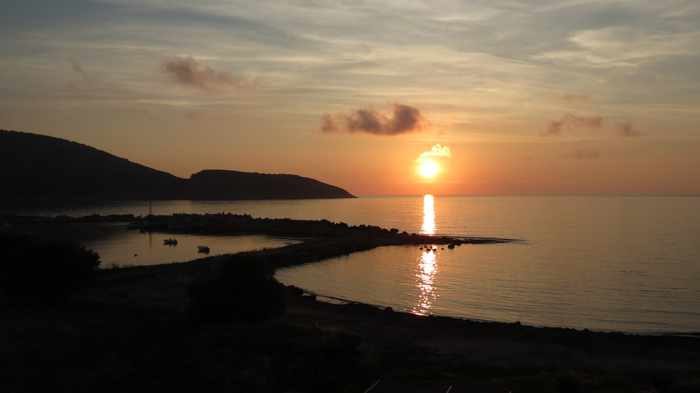
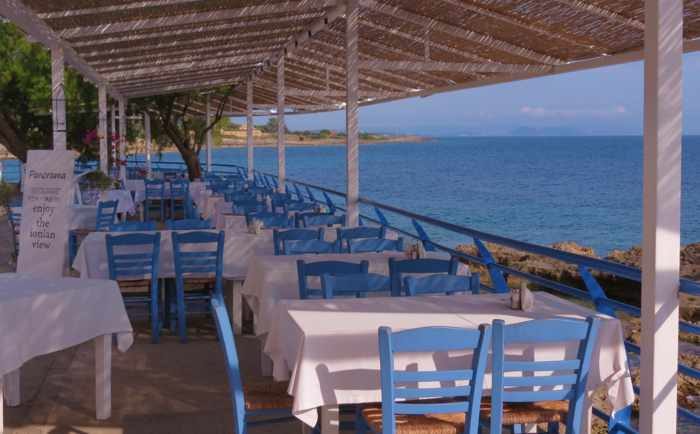
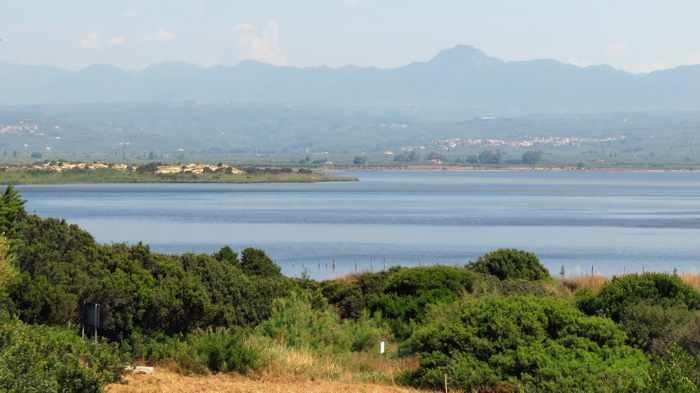
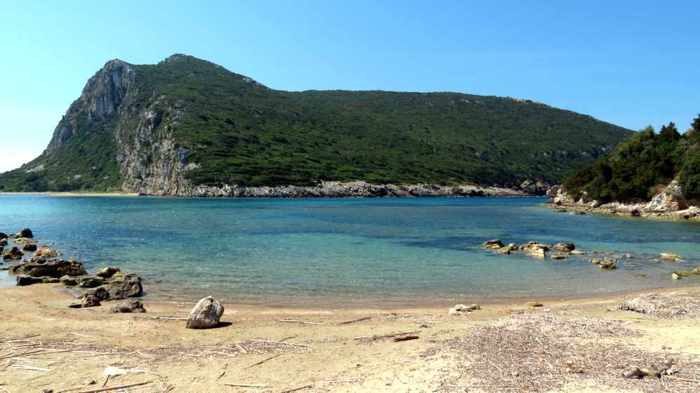
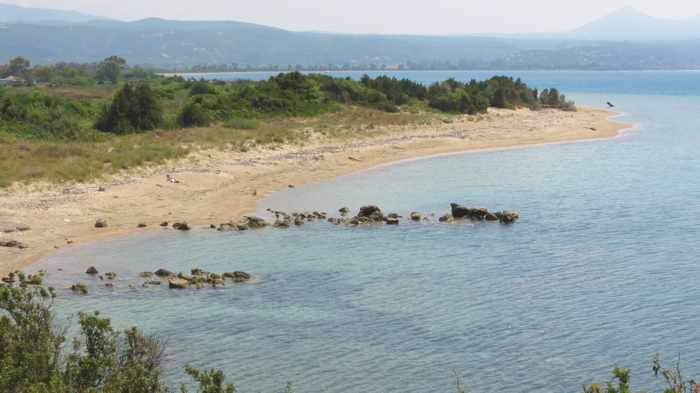
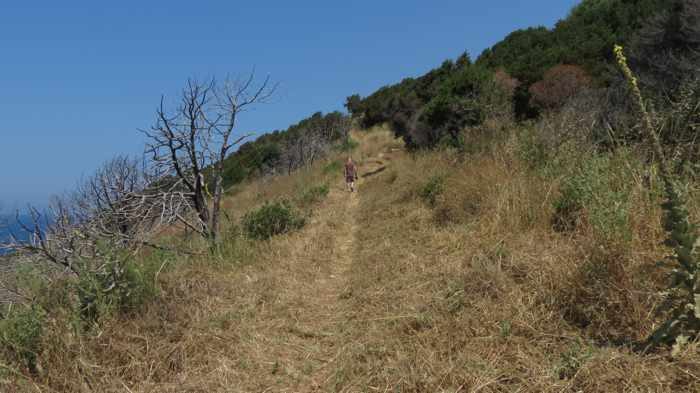
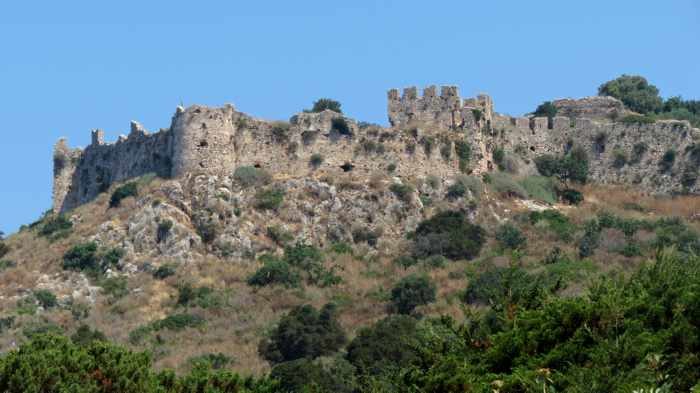
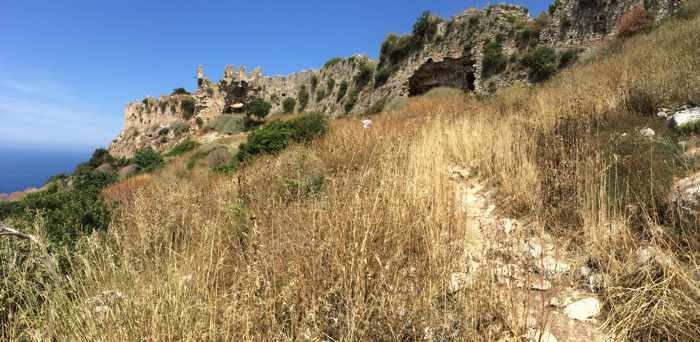
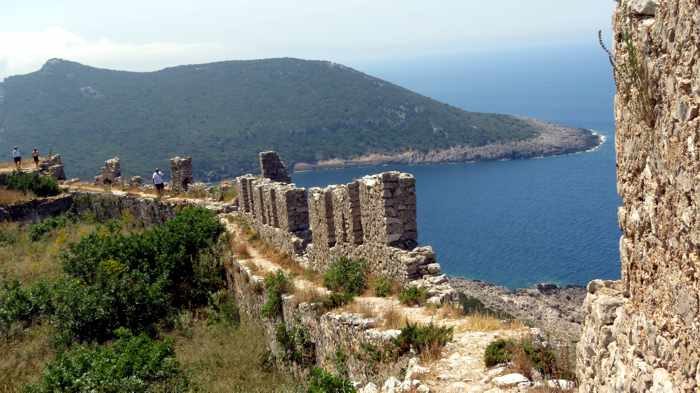
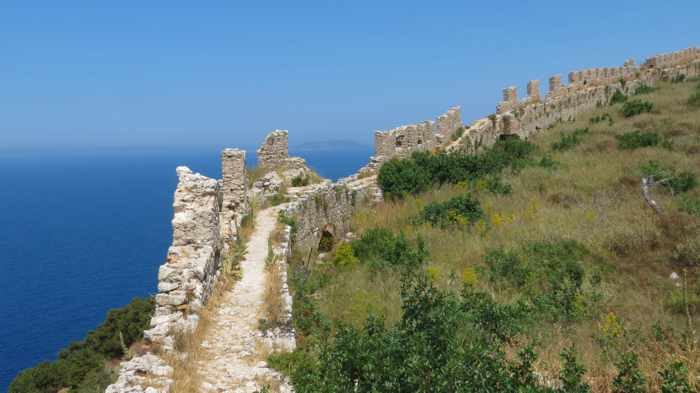
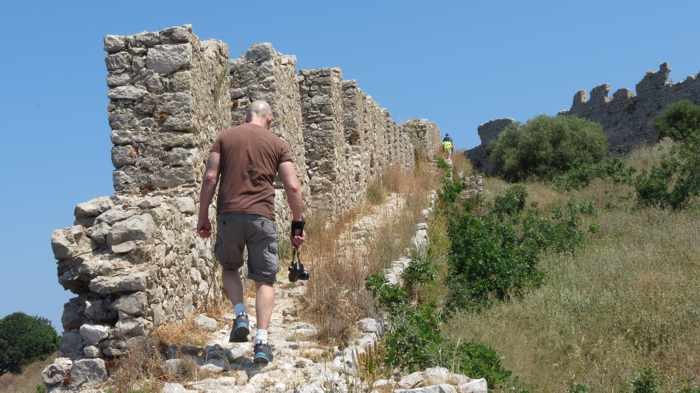
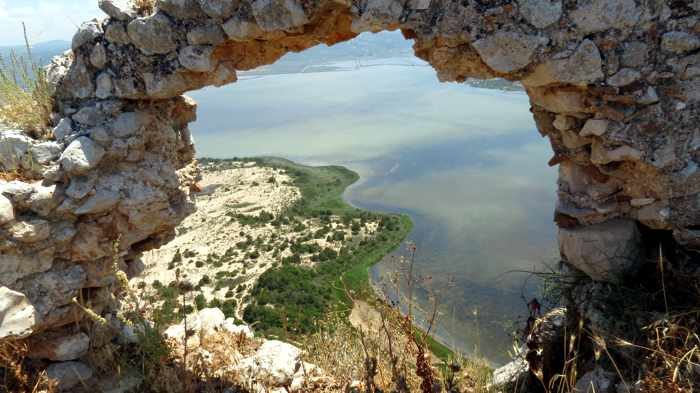
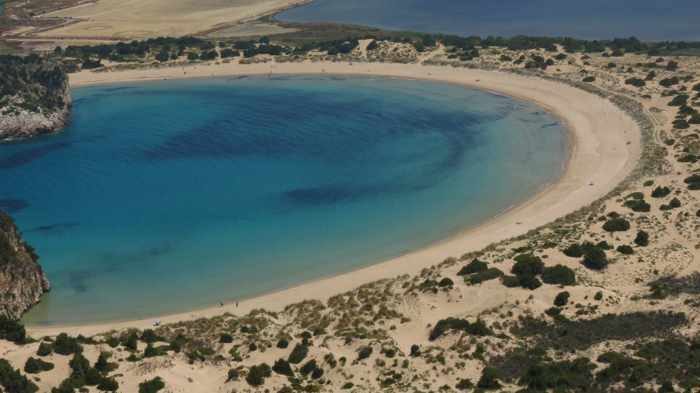
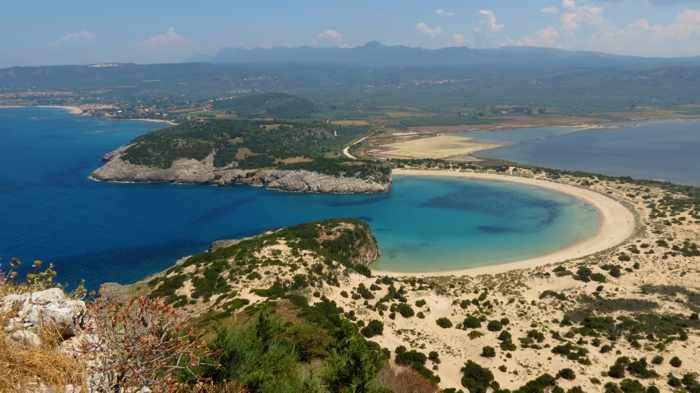
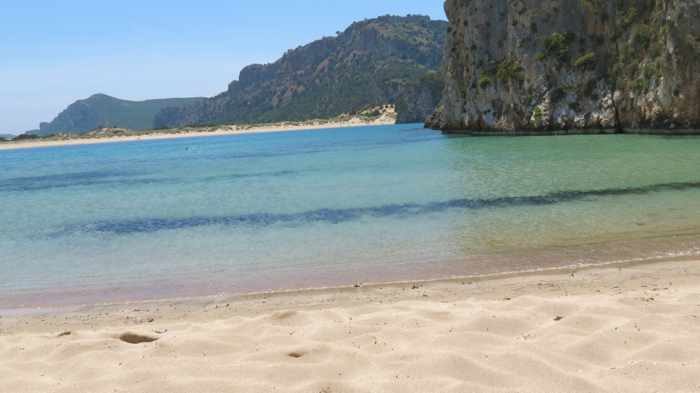
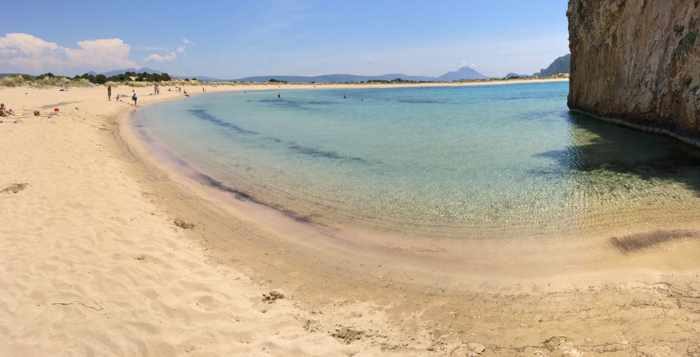
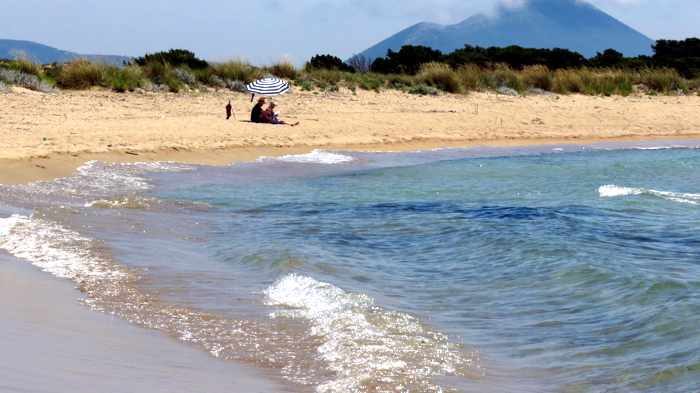
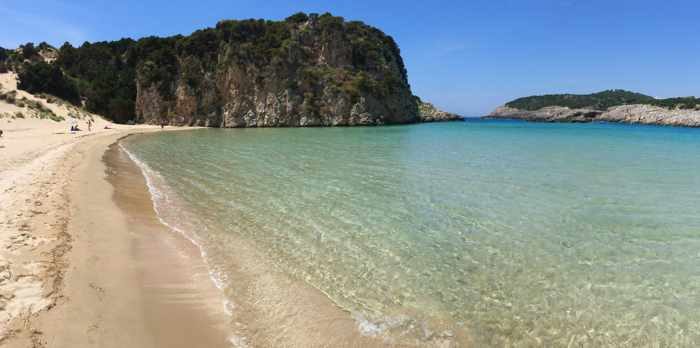
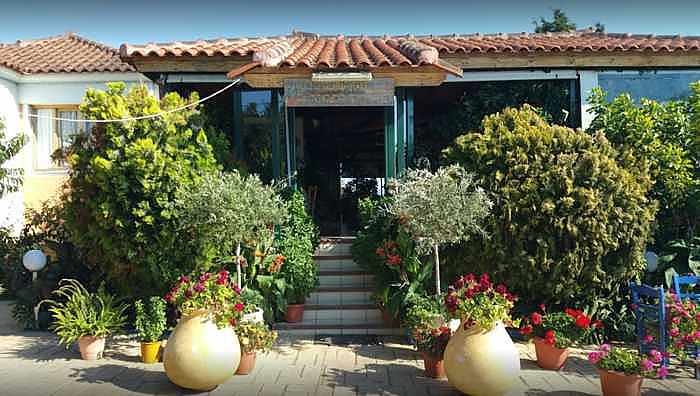
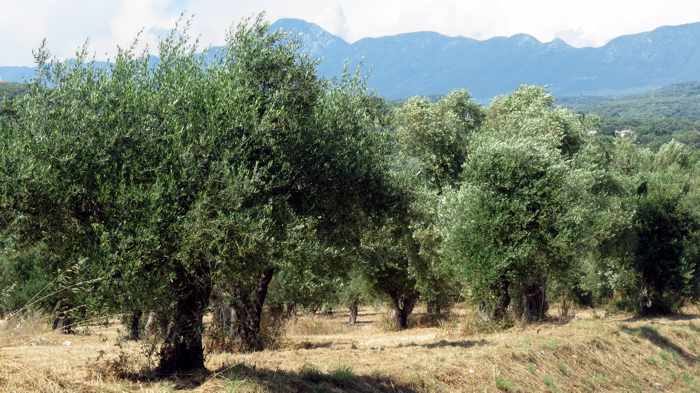
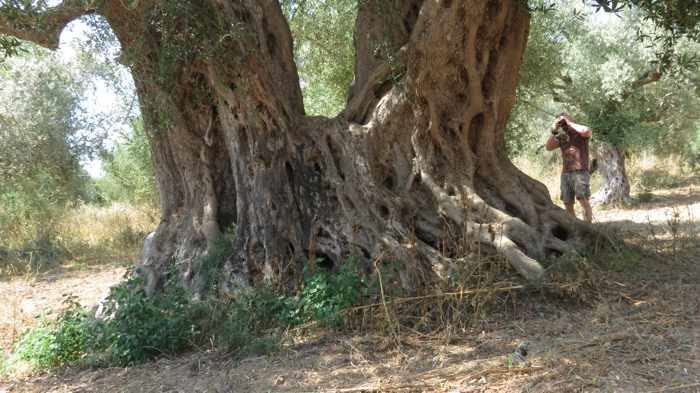
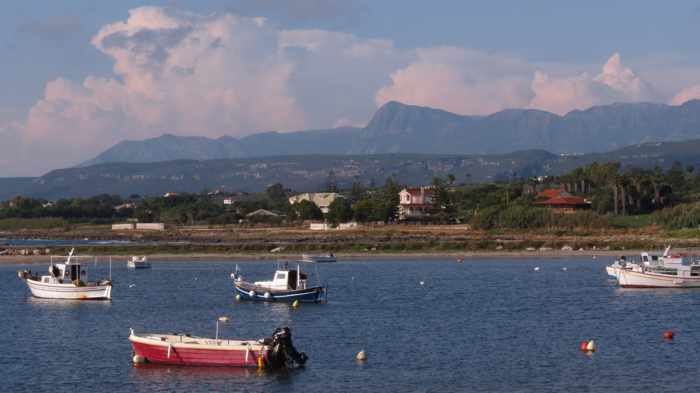
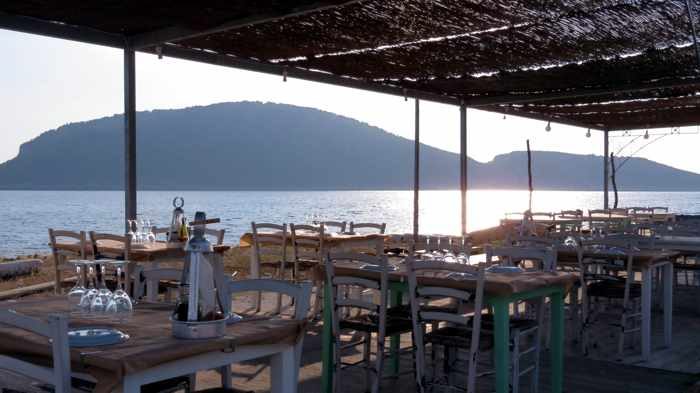
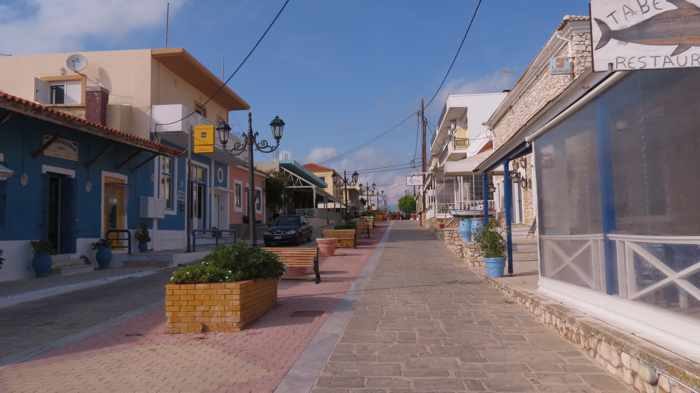
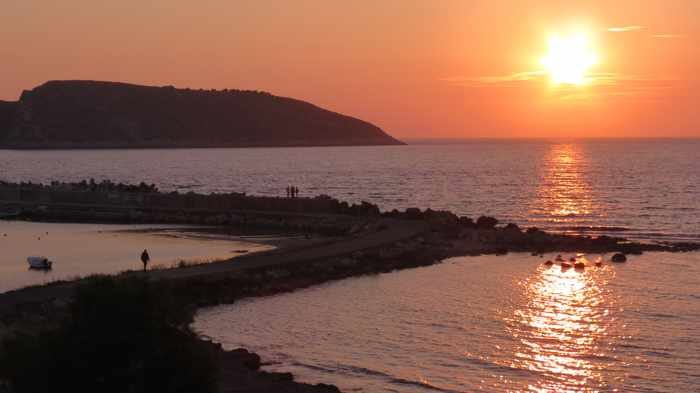
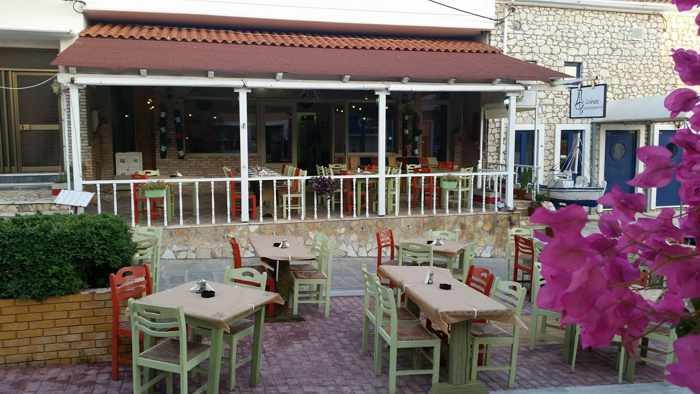
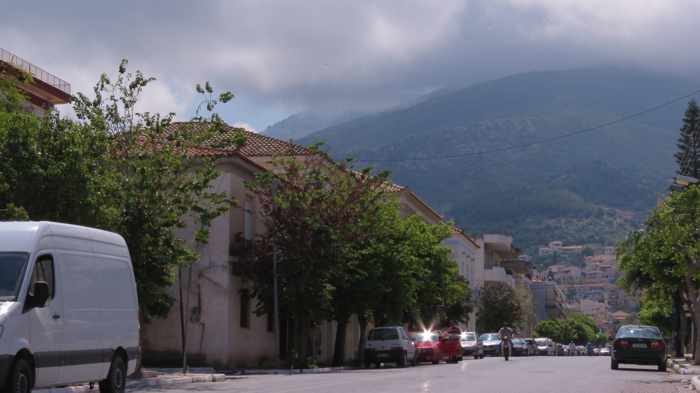
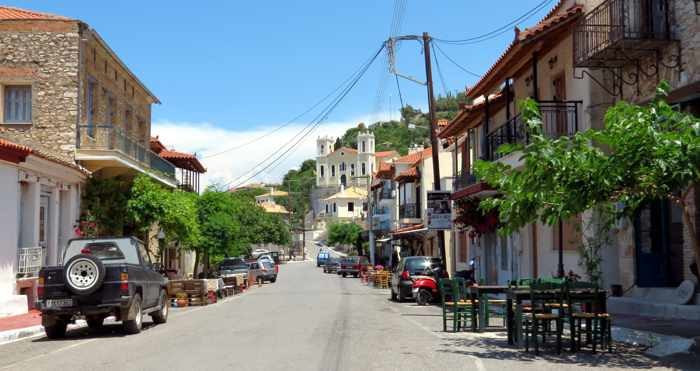
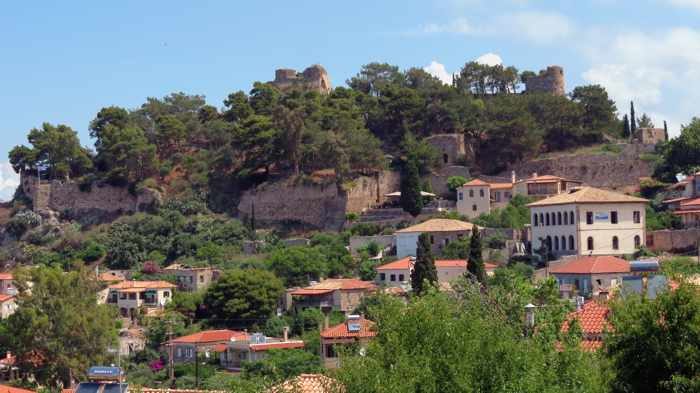
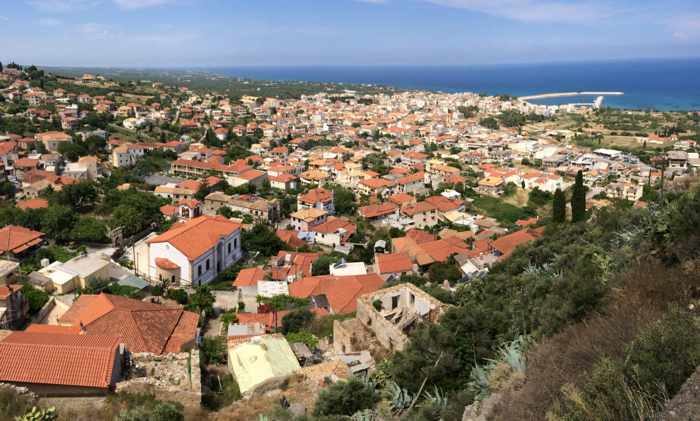
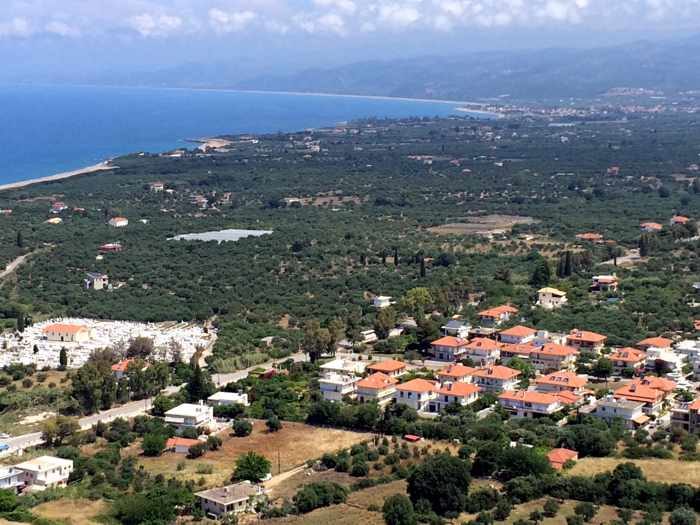
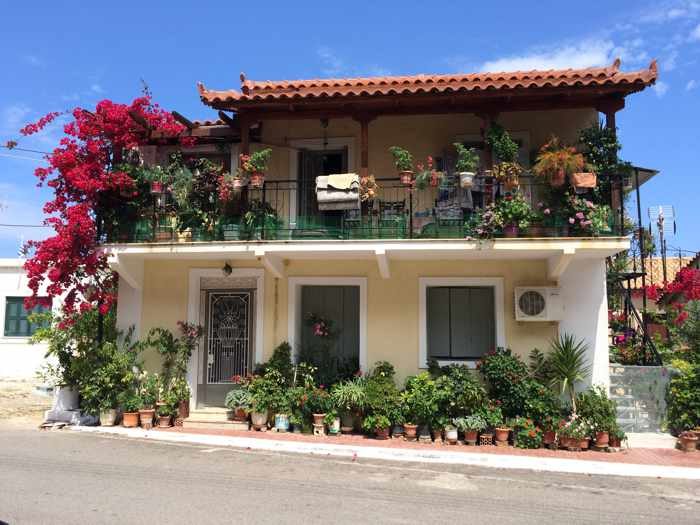
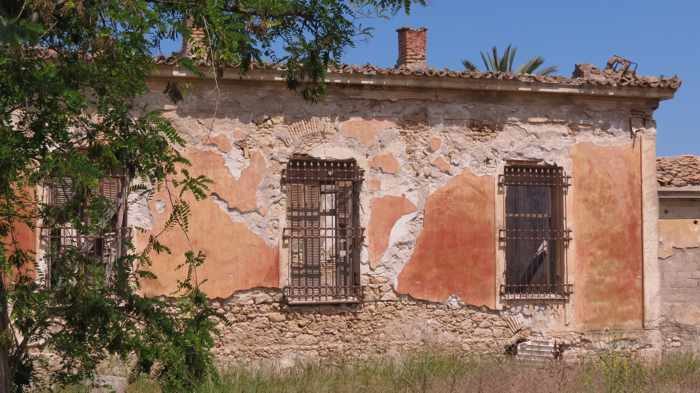
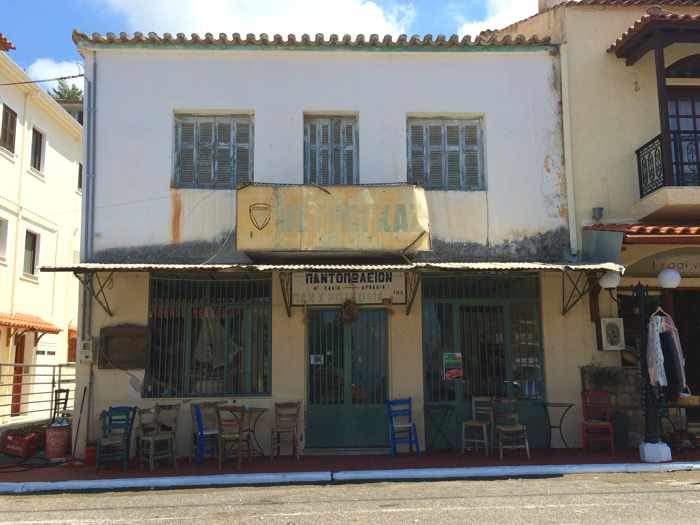
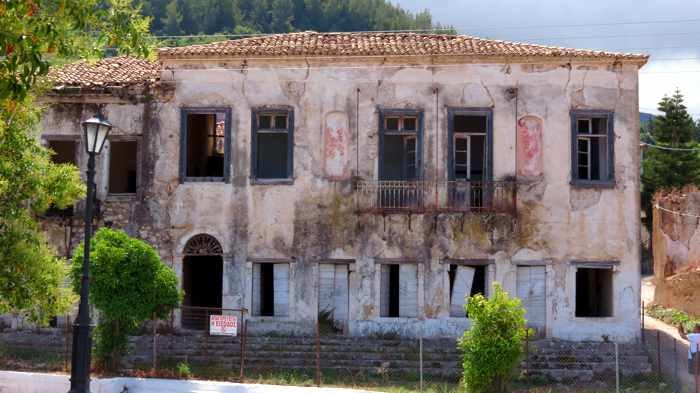
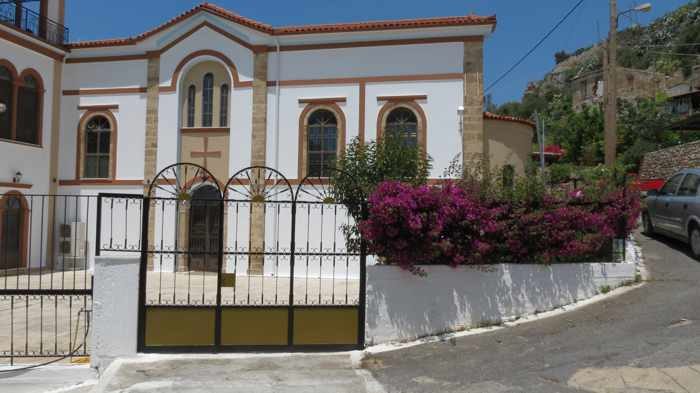
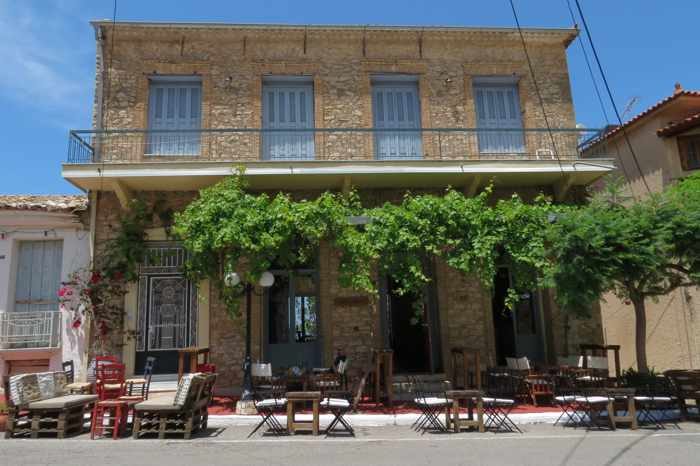
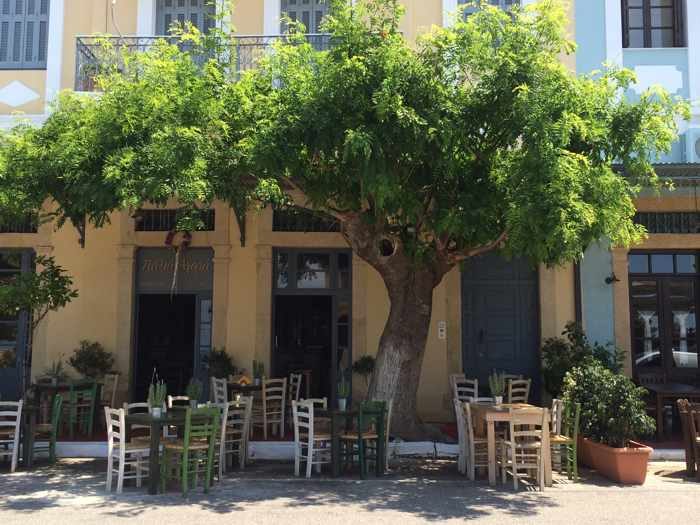
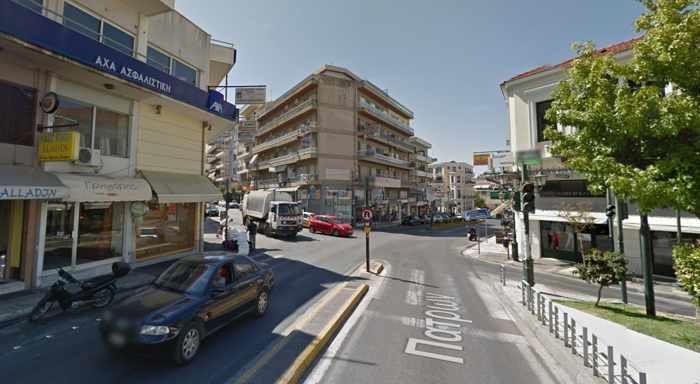
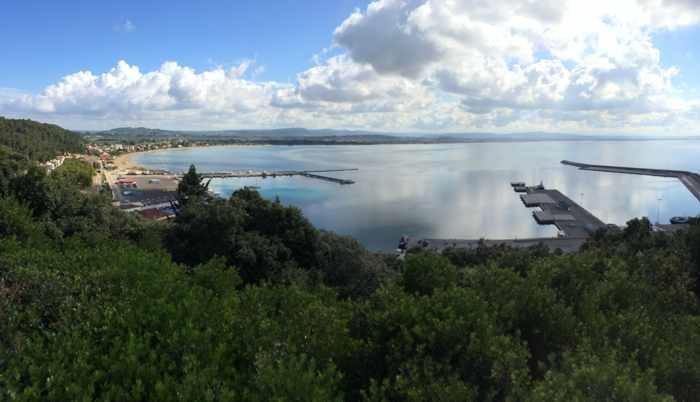
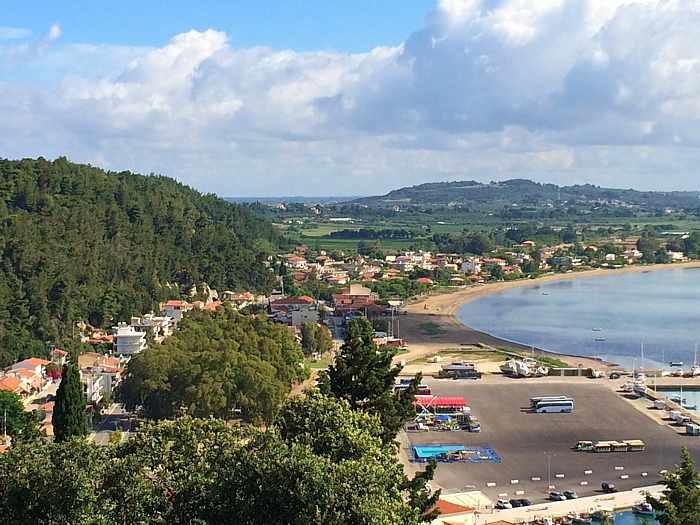
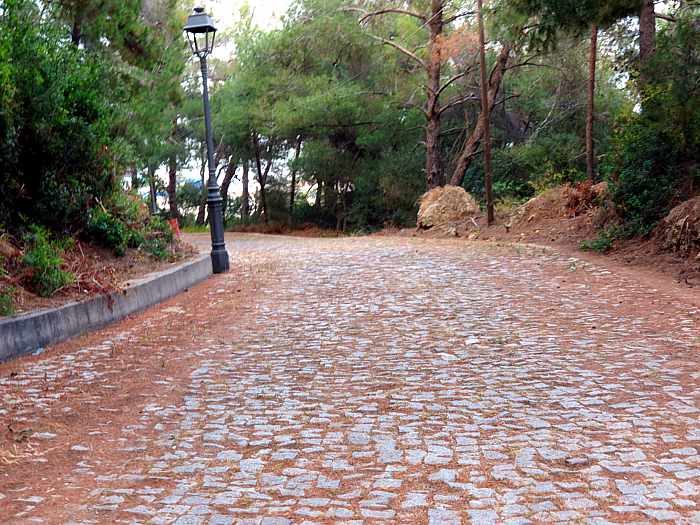
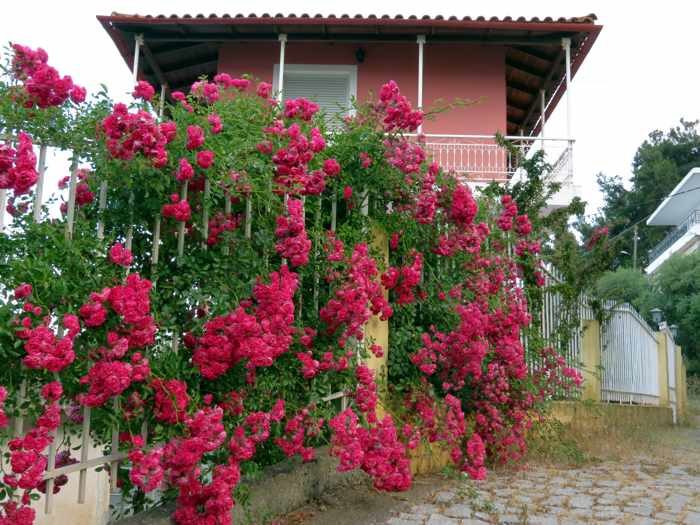
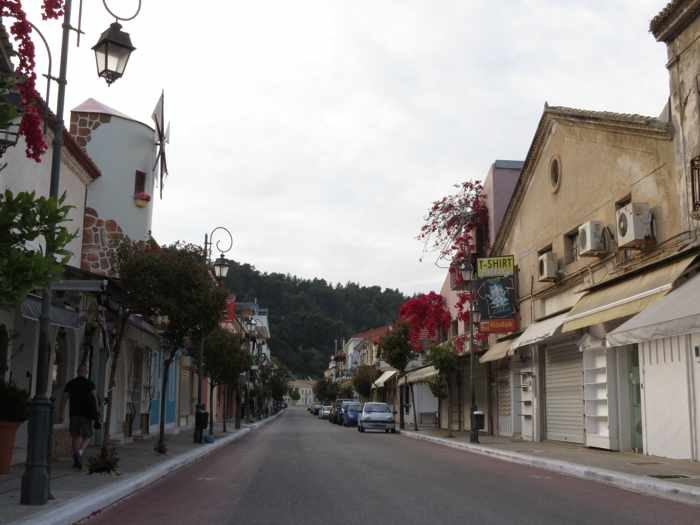
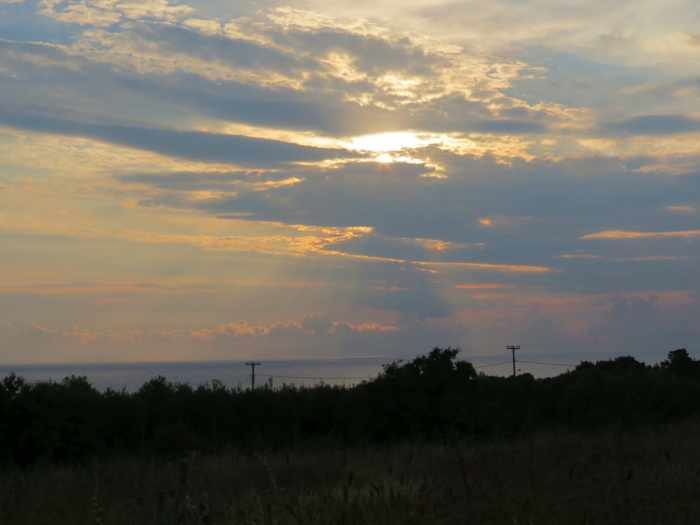
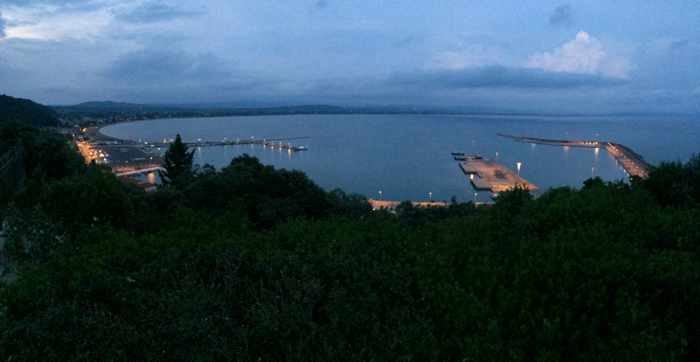
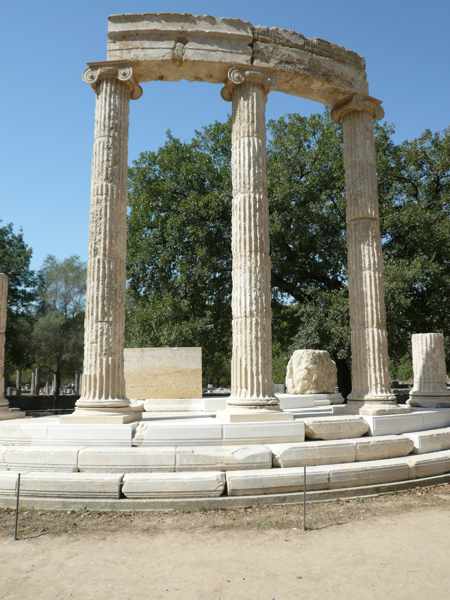
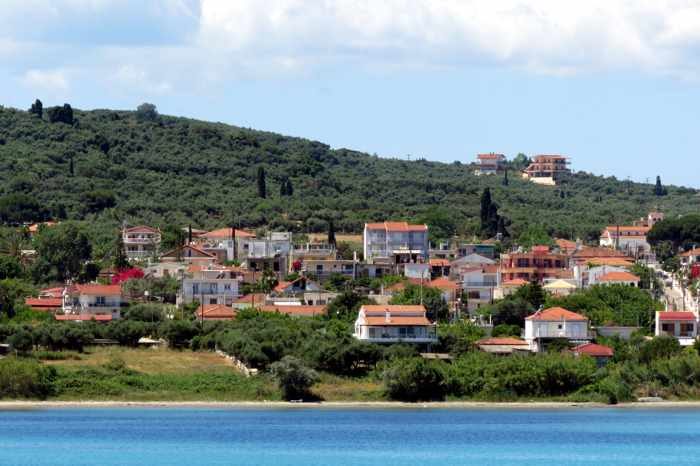
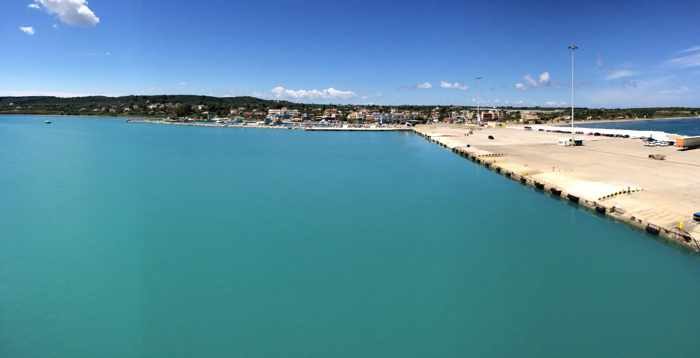


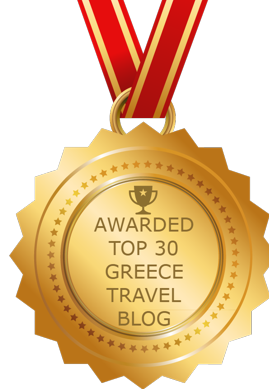

0 Comments
1 Pingback